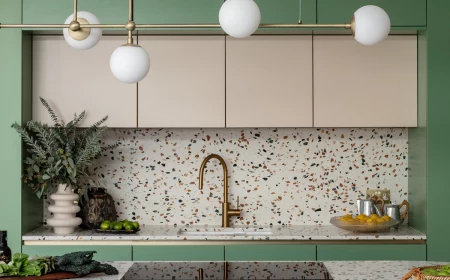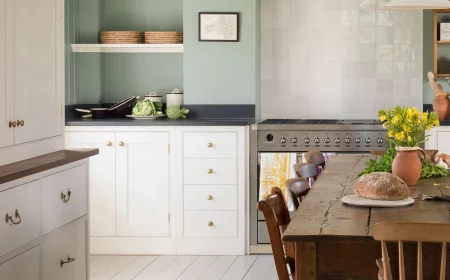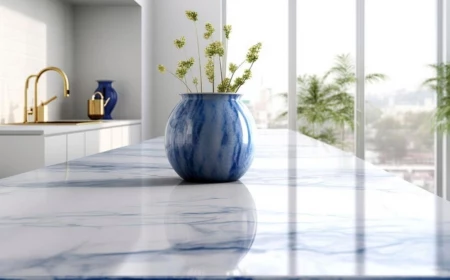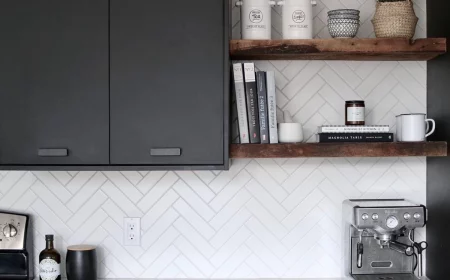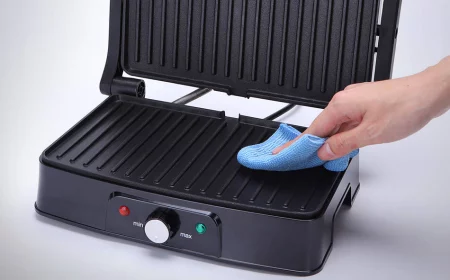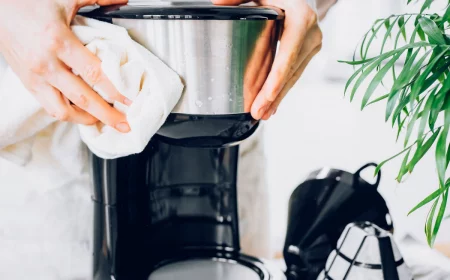Thinking About a Black Kitchen? Read This First.
I’ve been designing and building cabinets for a long time, and I’ve seen just about every kitchen trend you can imagine. But black kitchens… they’re different. They’re not just a passing fad. When you get them right, they have this incredible strength and timeless feel that’s hard to beat.
In this article
- The Science of Black: Why It Works (And When It Fails)
- Let’s Talk Fingerprints (And How to Beat Them)
- Not All Black is Created Equal: A Deep Dive into Materials & Finishes
- Building the Whole Look: It’s More Than Just Cabinets
- The DIY Route & Long-Term Care
- Is a Black Kitchen Right for You?
- Galerie d’inspiration
I still remember one of the first all-black kitchens I worked on. The client had a vision, but the contractor was nervous, worried it would feel like a dark cave. We leaned into the details—focusing on the finish, the lighting, and the mix of textures. The result was absolutely stunning. It was dramatic, yes, but also warm and unbelievably functional. That project taught me a huge lesson: a black kitchen isn’t really about the color. It’s about understanding material, light, and balance.
So, this isn’t a post to tell you black is “in.” Good design lasts a lifetime. My goal here is to pass along the practical, hands-on knowledge I’ve picked up over the years. We’re going to cover the nitty-gritty details that make the difference between a high-end, durable black kitchen and one that looks cheap or becomes a maintenance nightmare.
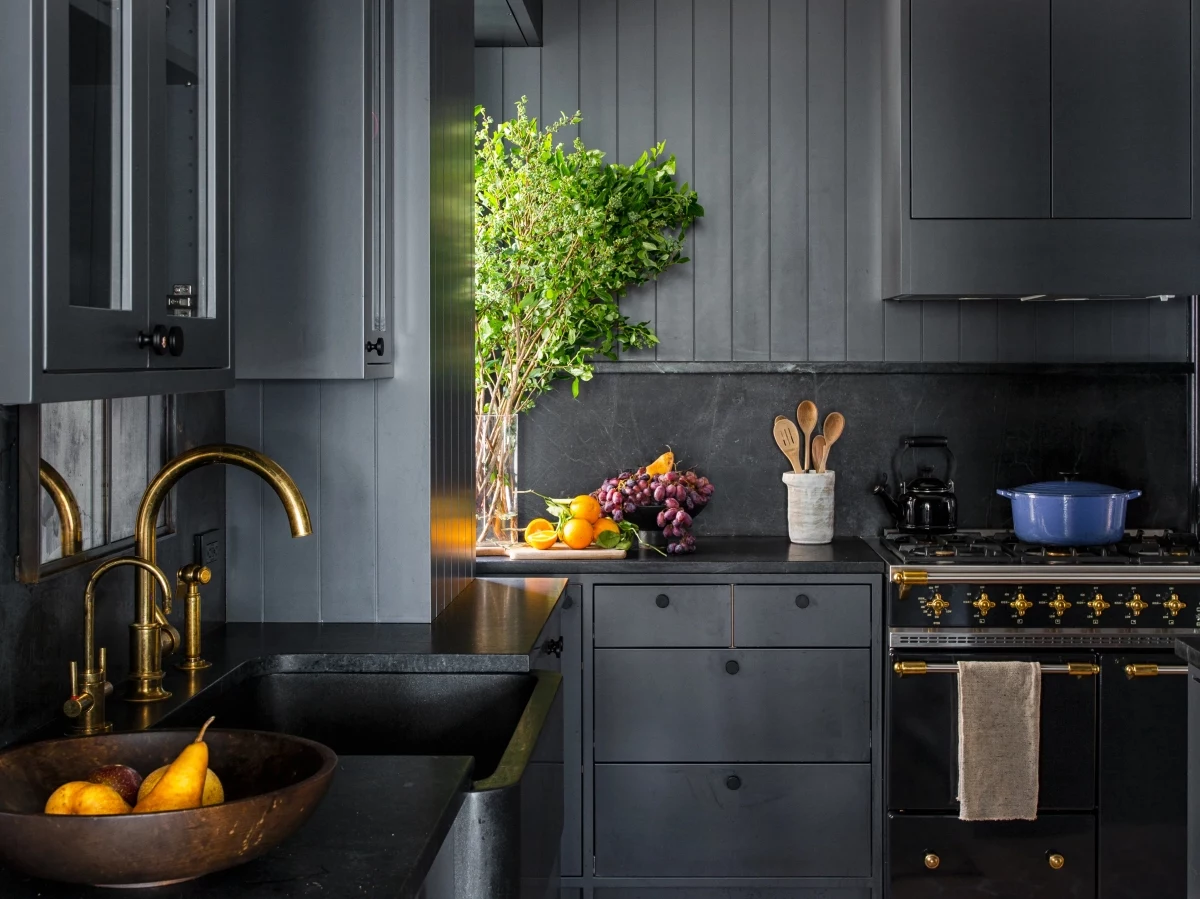
First, a Quick Reality Check
Before you even start looking at samples, try this little experiment. Take a black trash bag or a big black t-shirt and tape it over one of your current upper cabinet doors. Leave it there for a full day. Walk by it, look at it in the morning light, and see how it feels at night. Does it feel dramatic and sophisticated? Or does it just look like a black hole sucking the life out of your room? Your gut reaction is your first, and maybe most important, clue.
The Science of Black: Why It Works (And When It Fails)
Okay, let’s talk about some basic physics, because it’s the single most important factor here. White surfaces reflect light; black surfaces absorb it. Simple, right? But that one fact has massive consequences for your kitchen.
Because black cabinets soak up light, they can make a space feel smaller or more enclosed. Now, this isn’t always a bad thing! In a big, open-concept home, black cabinets are fantastic for creating a cozy, defined kitchen zone. They can make a soaring ceiling feel more grounded and intimate. The effect can be incredibly chic and dramatic.
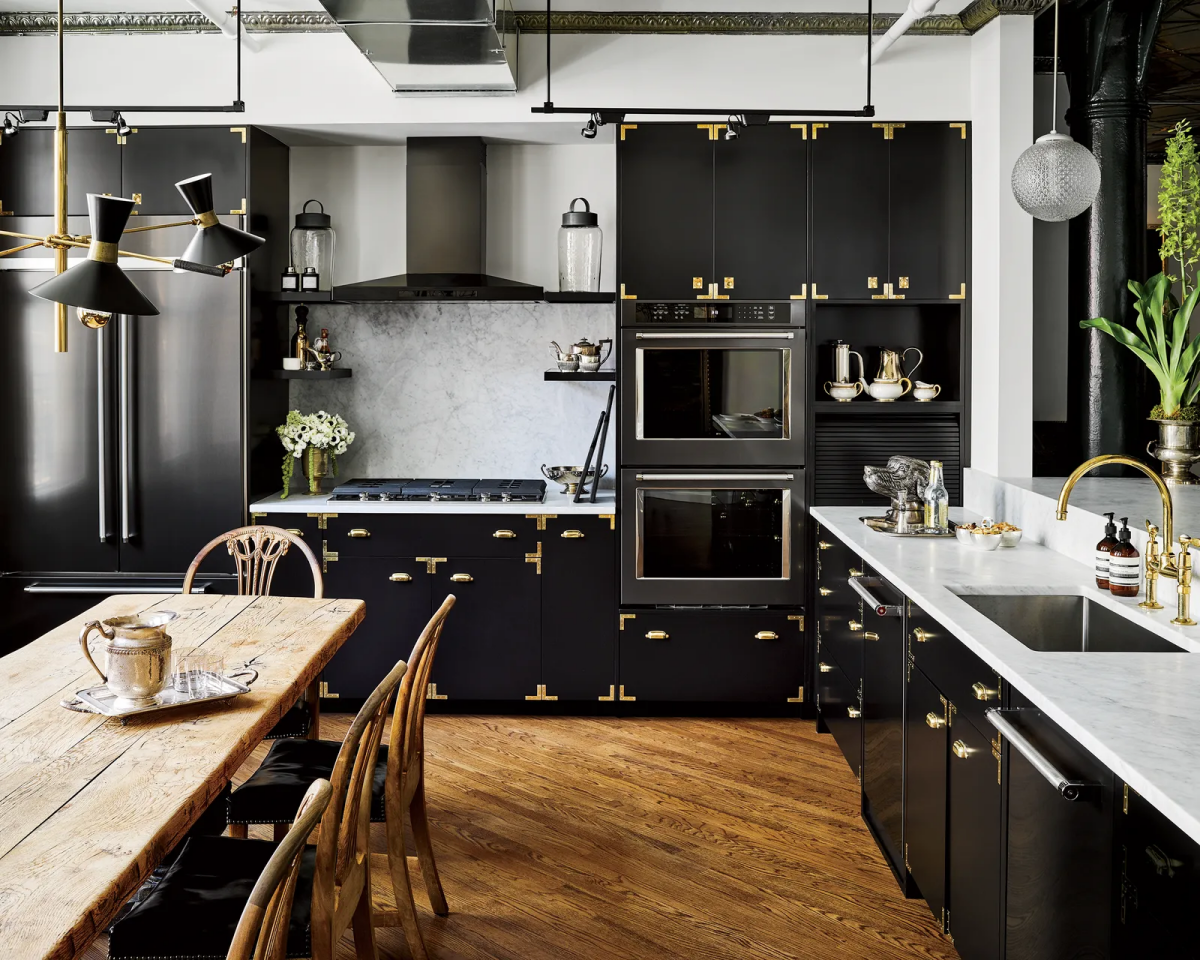
But in a small kitchen with very little natural light? It can be a recipe for disaster. I once consulted on a project where a homeowner put matte black cabinets in a narrow galley kitchen with just one small, north-facing window. The room felt heavy, and the regret was immediate. That’s why I have a couple of non-negotiable rules for anyone thinking about going all-in on black.
Heads up! Avoid these two common mistakes:
- Skimping on Lighting: This is the #1 reason black kitchens fail. You absolutely cannot rely on a single light fixture in the ceiling. You need a layered lighting plan—we’ll get into the specifics later—to put back the light that the black surfaces are absorbing. It’s not a suggestion; it’s a requirement.
- Ignoring Your Space: Be brutally honest about your room’s size and natural light. If it’s small and dark to begin with, all-black cabinets might not be your friend. A two-tone design, maybe with black lower cabinets and white or wood uppers, is a brilliant compromise that can ground the space without completely overwhelming it.

Let’s Talk Fingerprints (And How to Beat Them)
This is it. The number one fear everyone has about dark cabinets. And it’s a valid concern! Nothing ruins a sleek look faster than a constellation of smudges and fingerprints.
Honestly, how much of a problem this is comes down almost entirely to the finish and sheen you choose. A super glossy, mirror-like finish will show every single touch. On the other end of the spectrum, a very flat, chalky matte finish can also be a magnet for the oils from your hands, which can be tough to wipe away without “burnishing” or creating shiny spots over time.
The sweet spot for hiding fingerprints is a satin or eggshell finish. It has just enough sheen to make it easy to wipe down, but not so much that it reflects every little mark. By the way, the hardware you choose also plays a huge role. Using pulls instead of knobs, or even better, integrated channel pulls, means you aren’t touching the cabinet face at all. Problem solved.
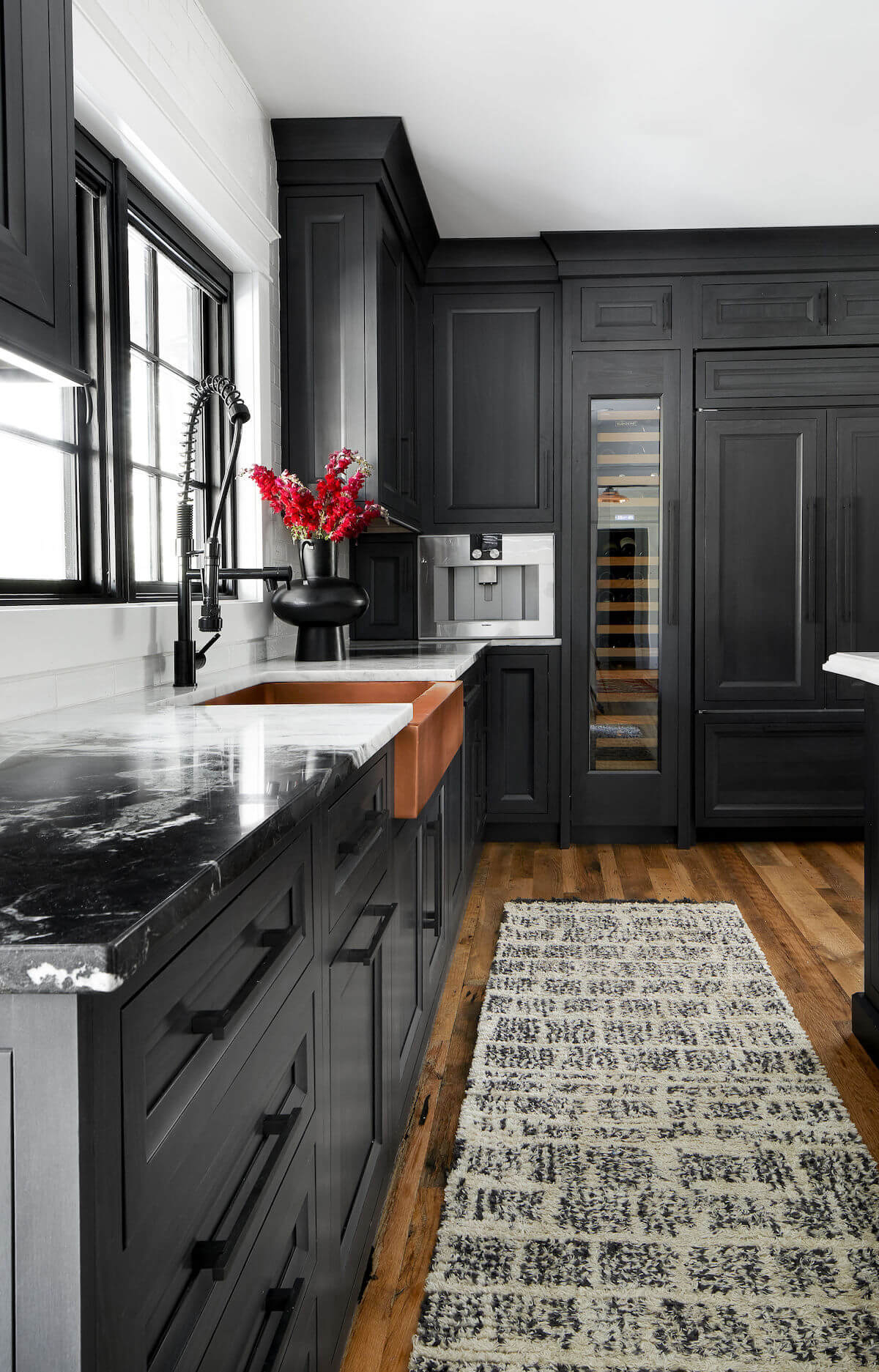
Good to know: There are some amazing new materials out there, especially high-end European laminates, that come with anti-fingerprint technology. They have a unique surface structure that diffuses light and resists oils. They can be pricier, but for a busy family kitchen, they can be a total game-changer.
Not All Black is Created Equal: A Deep Dive into Materials & Finishes
“Black” is just the beginning. The actual material of the cabinet and the finish on top of it will dictate the look, feel, and, most importantly, the durability. This is where cutting corners can really come back to bite you.
The Cabinet Material Itself
What’s underneath the color matters a ton.
- Painted MDF (Medium-Density Fiberboard): For a solid, opaque black, this is the industry standard for a reason. MDF is super stable and doesn’t expand and contract with humidity like solid wood. That means you won’t get those tiny hairline cracks in the paint at the joints over time. It’s the perfect canvas for a smooth, flawless painted finish.
- Stained Solid Wood (like Oak or Ash): If you love the idea of black but still want to see some natural texture, stained wood is the way to go. Woods with a strong grain, like oak or ash, look incredible with a black stain that lets the texture pop. A pro technique is a “cerused” finish, where the grain is enhanced with a contrasting color for a really rich, custom look.
- Laminates & Thermofoil: These are often the more budget-friendly routes. A thin layer of black plastic material is basically fused to an MDF core. And they’ve come a long way! Some modern laminates offer incredible textures and that fingerprint-resistant tech I mentioned. The main drawback is that lower-quality versions can peel over time, especially near a hot oven or steamy dishwasher.
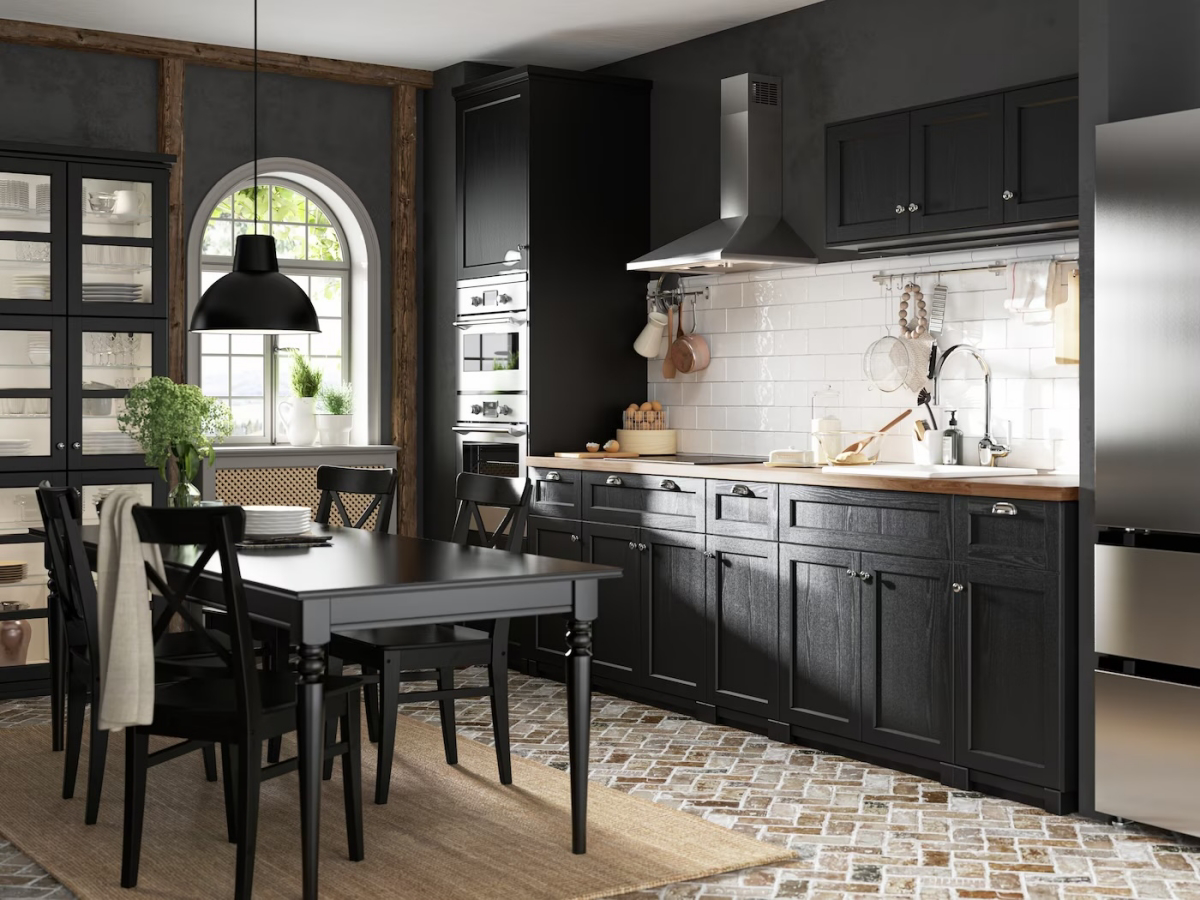
Choosing the Right Sheen
The sheen, or how glossy the finish is, is a huge decision. I always tell clients to look at large sample doors in their own kitchen light before they commit. Here’s the breakdown:
- Matte: Gives you a soft, velvety, and very modern look. It’s great at hiding minor surface imperfections. The downside? It’s the hardest to clean. The texture that makes it look so good can trap oils and fingerprints. I’d reserve this for lower-traffic areas or homes without young kids.
- Satin/Eggshell: This is my go-to recommendation and the workhorse of kitchen finishes. It strikes the perfect balance. It looks sophisticated and low-key but is smooth enough to be wiped down easily. It’s the best of both worlds, truly.
- Semi-Gloss: A bit more reflective and very durable. It’s a breeze to clean, but it will highlight every single smudge, fingerprint, and any tiny imperfection on the surface itself. It can sometimes look a bit like plastic if not executed perfectly.
- High Gloss: This is the ultra-modern, mirror-like finish you see in sleek European designs. It’s stunning, but it’s a high-maintenance choice. It requires a flawless surface and a multi-step polishing process, similar to car paint. It’s also the most expensive and will show every speck of dust.
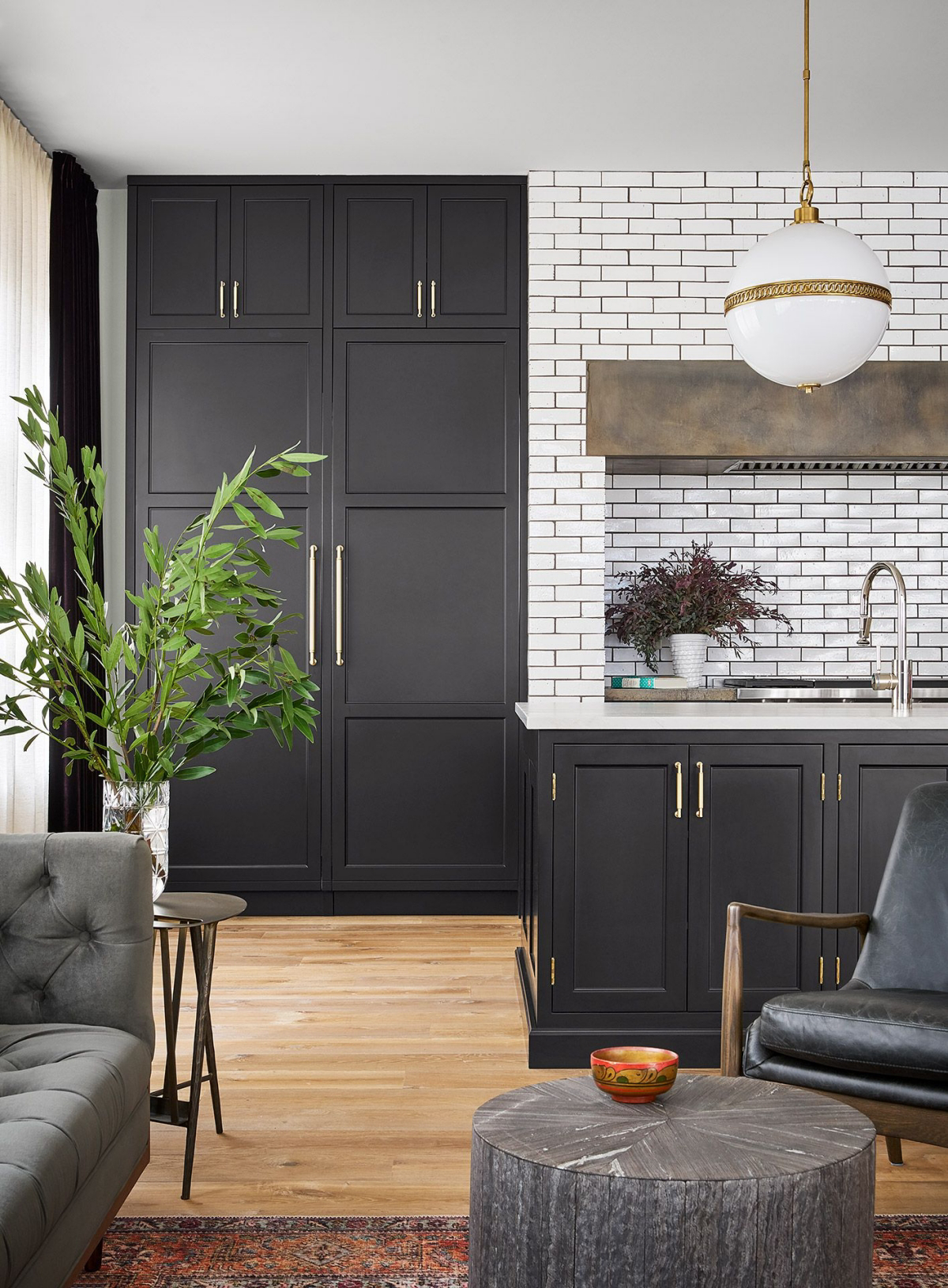
Building the Whole Look: It’s More Than Just Cabinets
A beautiful black kitchen is a total package. The cabinets are the star, but the supporting cast of lighting, hardware, and surfaces is what makes the whole thing sing.
The Layered Lighting Plan
I know I’m repeating myself, but it’s that important. You need three layers of light:
- Ambient Light: This is your general, room-filling light from recessed cans or a central fixture. For a typical 10×12 foot kitchen, I’d want to see at least six 4-inch recessed LED lights to get even coverage.
- Task Light: This is your workhorse light. The most crucial piece is under-cabinet lighting. It lights up your countertops so you can actually see what you’re chopping, eliminating the shadows your body and cabinets create. I always specify LED tape lighting with a warm-white color (around 3000K) and a high CRI (Color Rendering Index) of 90+ so your food looks like food, not something from a sci-fi movie.
- Accent Light: This is the jewelry. It’s the fun stuff, like puck lights inside glass-front cabinets, lighting above the uppers to create a glow on the ceiling, or even an LED strip under the toe-kick for a cool, floating effect.
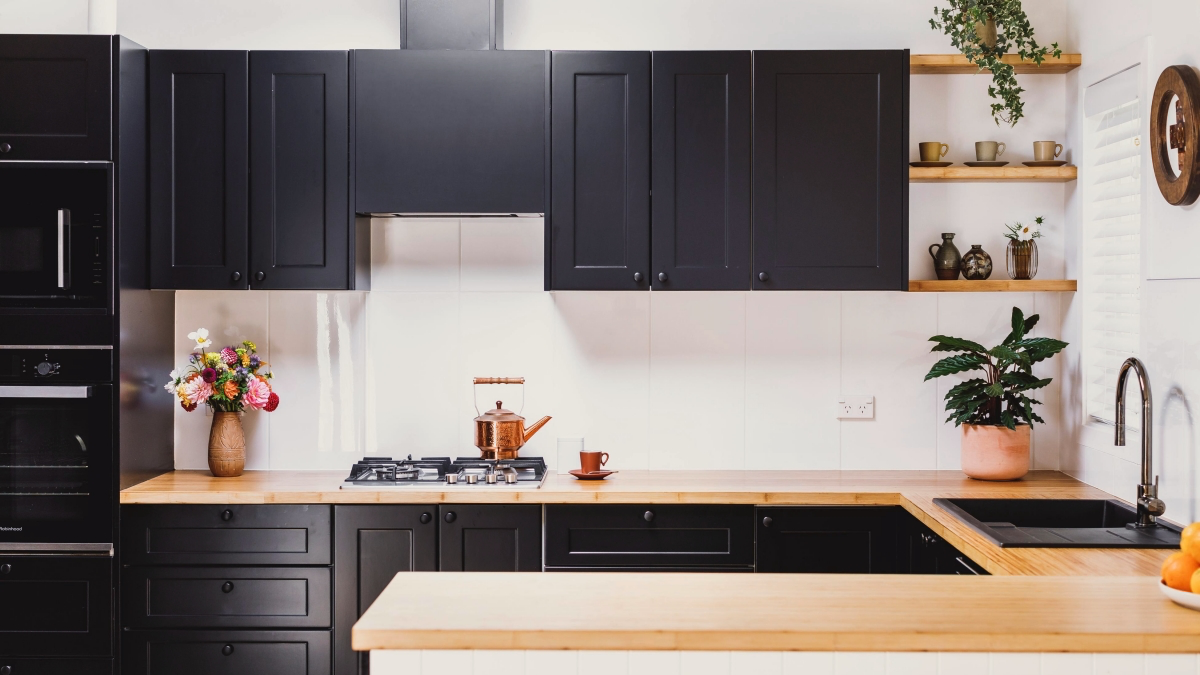
Hardware & Countertops
Hardware on black cabinets is a big statement. A warm brass or bronze can feel classic and warm, while brushed nickel or matte black is more modern. I’m a fan of brands like Rejuvenation or Top Knobs for quality that you can really feel. Expect to pay anywhere from $8 to $30+ per pull, depending on the material.
For countertops, you don’t have to go with stark white. The goal is balance, and texture is your best friend. A quartz with warm, subtle veining, like something similar to Cambria Brittanicca Gold, can be stunning. Or for a softer, more industrial vibe, a honed black granite like Virginia Mist is a fantastic choice because its matte texture doesn’t compete with the cabinets.
Don’t Forget Floors and Appliances!
The rest of the room is just as important. A light-colored wood floor can provide a beautiful, warm contrast and keep the room from feeling too heavy. Dark floors can also work for a super dramatic, monolithic look, but you need plenty of light to pull it off.
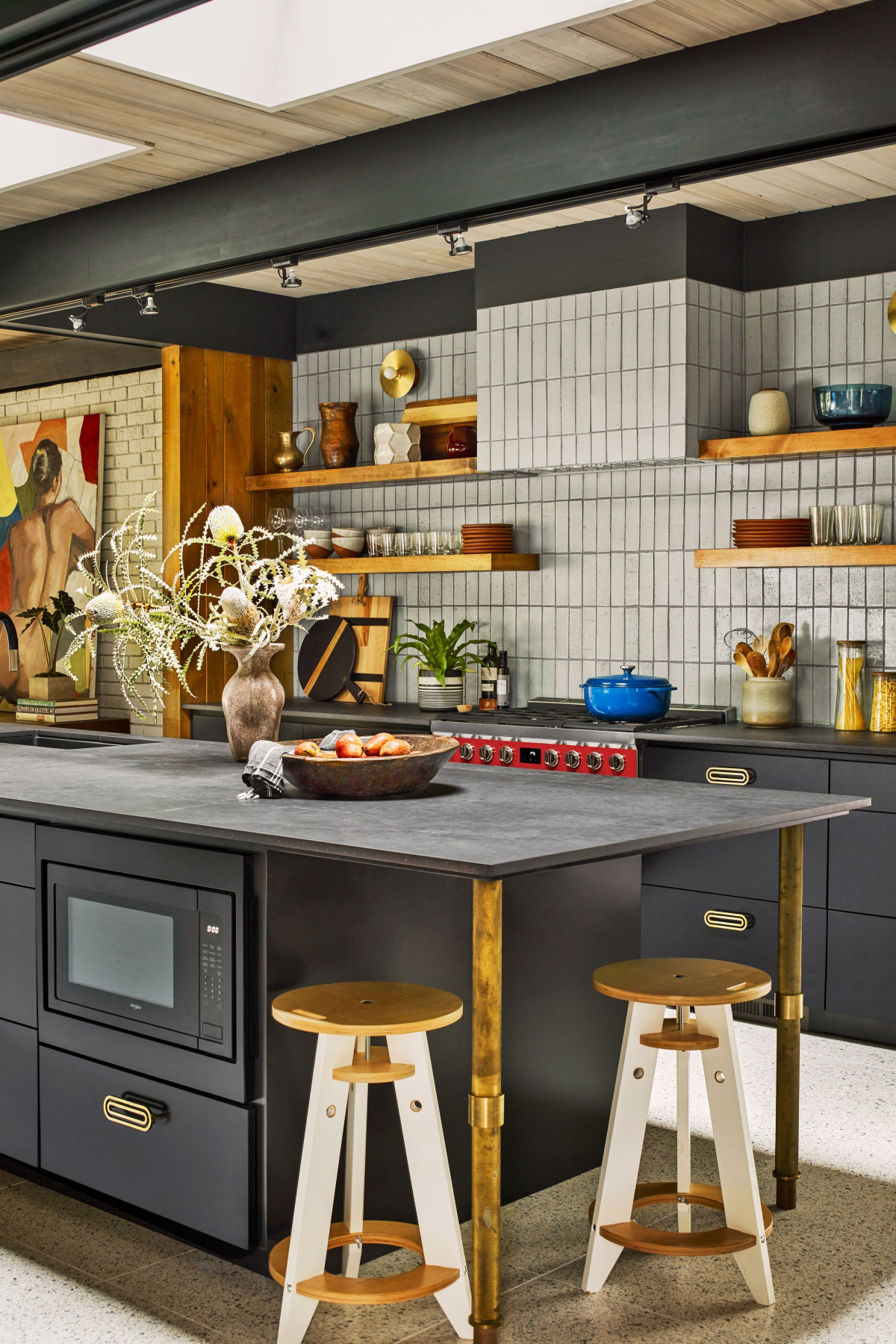
When it comes to appliances, you have options. Classic stainless steel breaks up the black and adds a professional touch. Black stainless steel can blend in for a sleeker look. Or, for a truly high-end, seamless design, panel-ready appliances that wear the same front as your cabinets are the ultimate choice.
The DIY Route & Long-Term Care
Can you just paint your existing cabinets black? Yes. But I need to be frank: it is one of the most tedious and unforgiving DIY projects you can tackle. If you’re going to do it, you cannot cut corners.
The prep work is everything. You have to scrub every surface with a strong degreaser (like a TSP substitute), sand everything to give the primer something to grip, and use a high-adhesion, stain-blocking primer. Seriously, don’t use regular wall paint primer. Spring for a shellac-based one like Zinsser B-I-N. Then, apply at least two thin coats of a quality cabinet paint, like a urethane-alkyd enamel.
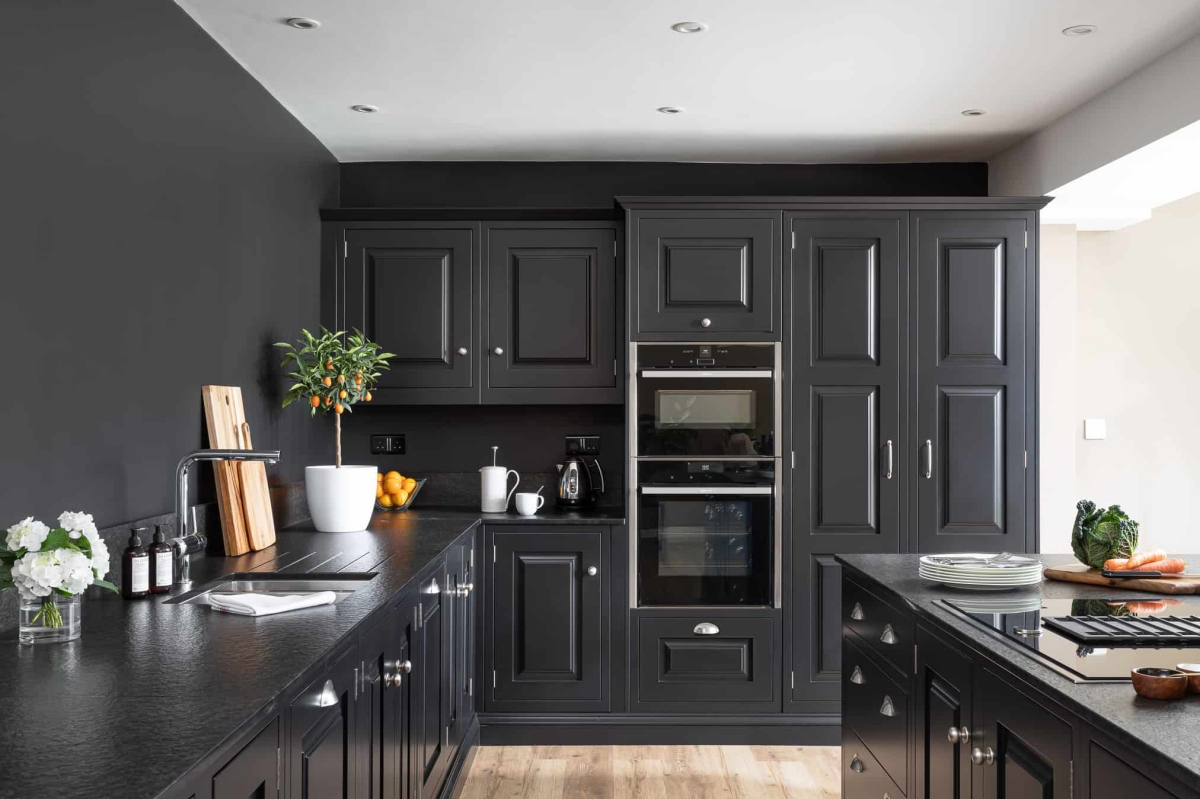
Quick Tip: A DIY Shopping List
- TSP Substitute Cleaner: ~$10
- Good Sandpaper (120 & 220 grit): ~$15
- Zinsser B-I-N Shellac-Based Primer: ~$25/quart
- Quality Urethane Alkyd Enamel Paint: ~$40/quart
- Respirator for VOCs (Don’t skip this!): ~$35
Plan for this to take a while. For an average-sized kitchen, you’re looking at 40-50 hours of actual work. And remember, paint takes time to cure (fully harden), which can be up to 30 days. Be gentle with them during that first month!
Protecting Your Investment
For day-to-day cleaning, just use a soft microfiber cloth, a little bit of warm water, and maybe a single drop of mild dish soap. Then, wipe it dry with a clean cloth to prevent water spots. Never, ever use abrasive scrubbers or harsh chemicals. For the inevitable chip or scratch, get a touch-up kit from your cabinet maker. It’s the only way to perfectly match the color and sheen.
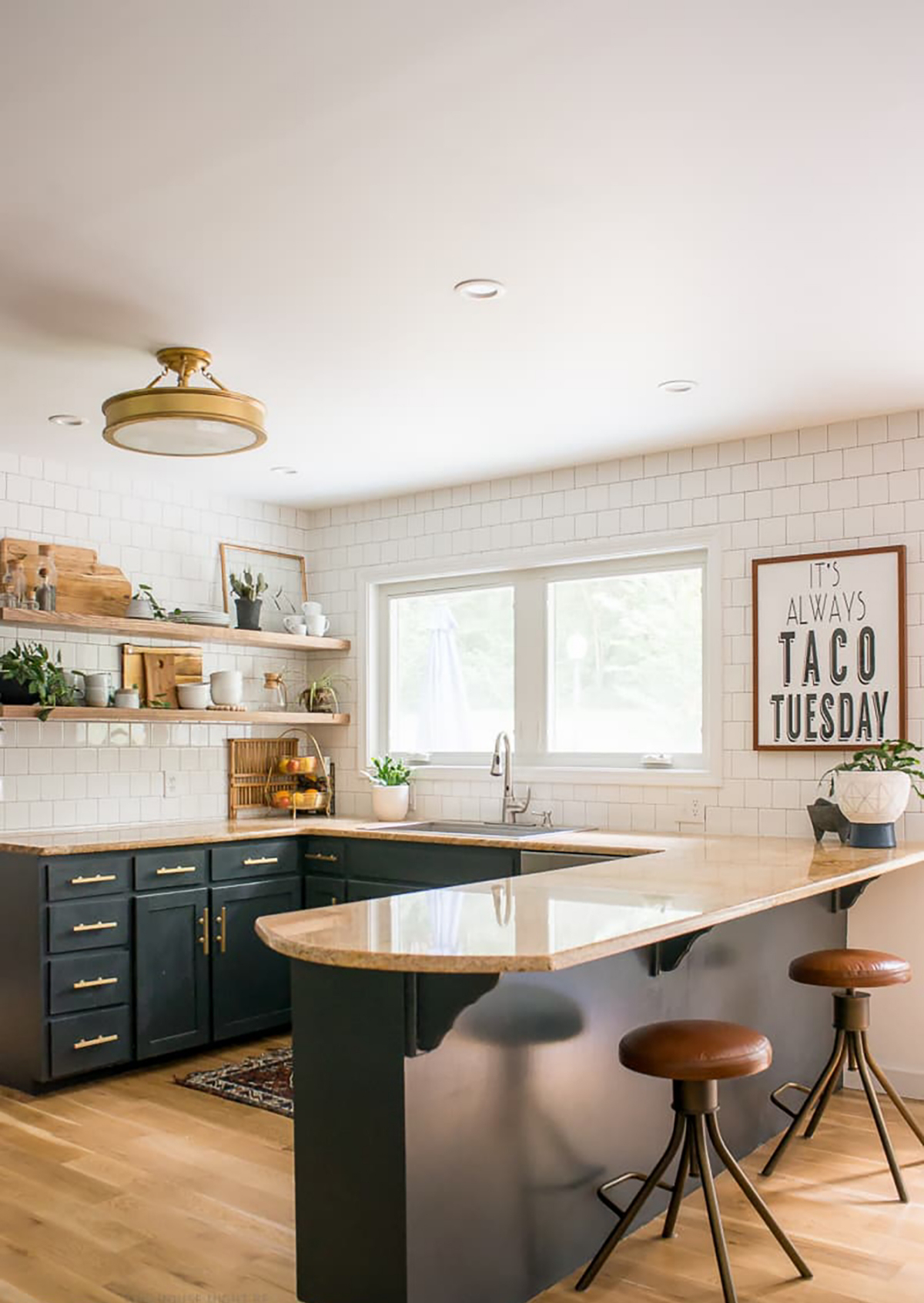
Is a Black Kitchen Right for You?
Choosing black cabinets is a bold move, no doubt about it. It requires more planning and a deeper consideration of things like light, texture, and balance. It’s not the right choice for every person or every home.
But when you plan it with care and execute it with quality materials, a black kitchen becomes more than just a place to cook. It becomes the true heart of the home—a space with serious depth, character, and a quiet confidence. And that’s a choice that will never go out of style.
Galerie d’inspiration
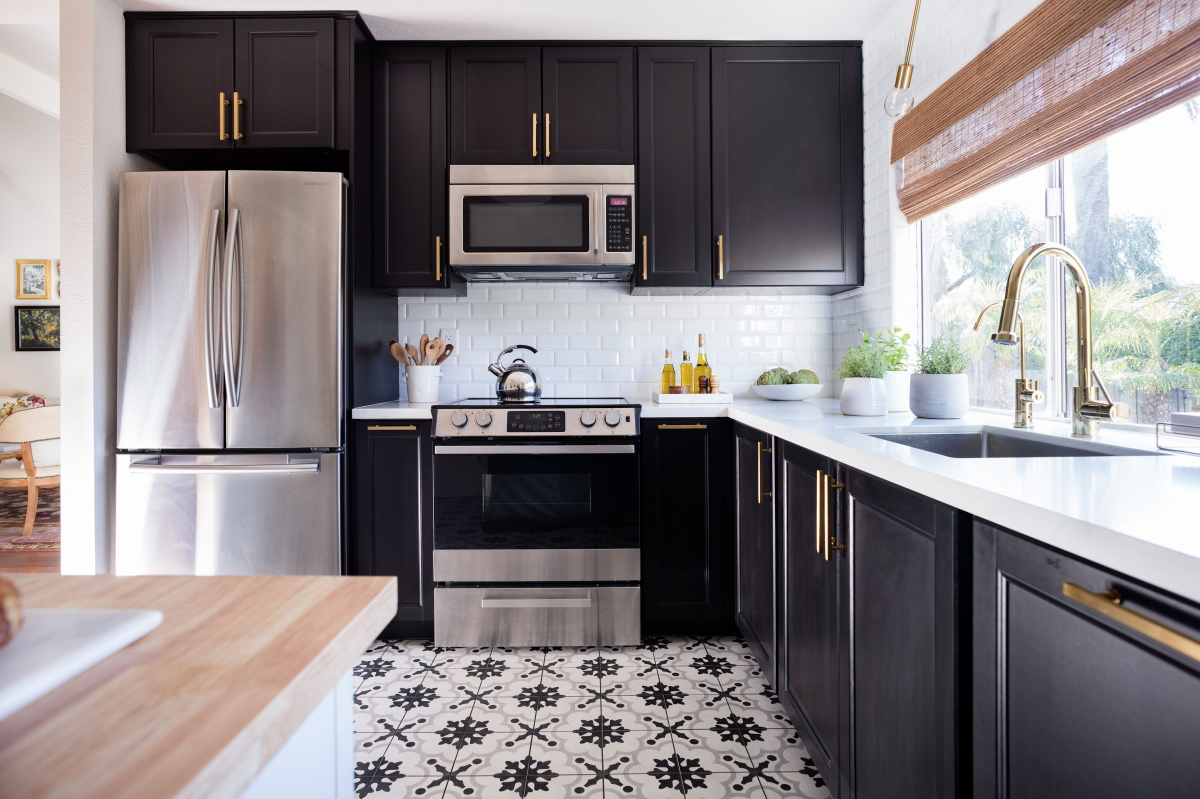
Which black finish is right for you? It’s not just about the look, but the living.
The Classic: Matte Lacquer. This finish offers a deep, velvety, and uniform color that’s undeniably sophisticated. It absorbs light beautifully, creating a soft, high-end feel. However, be prepared for maintenance: it’s more susceptible to fingerprints and can be tricky to clean without leaving streaks. Best for meticulous homeowners or less-used areas.
The Innovator: Fenix NTM®. A game-changer in kitchen materials. This nanotech surface is extremely matte, soft to the touch, and—crucially—anti-fingerprint. It also boasts thermal healing properties for superficial micro-scratches. It’s the pragmatic choice for a busy family kitchen where durability is as important as design.

